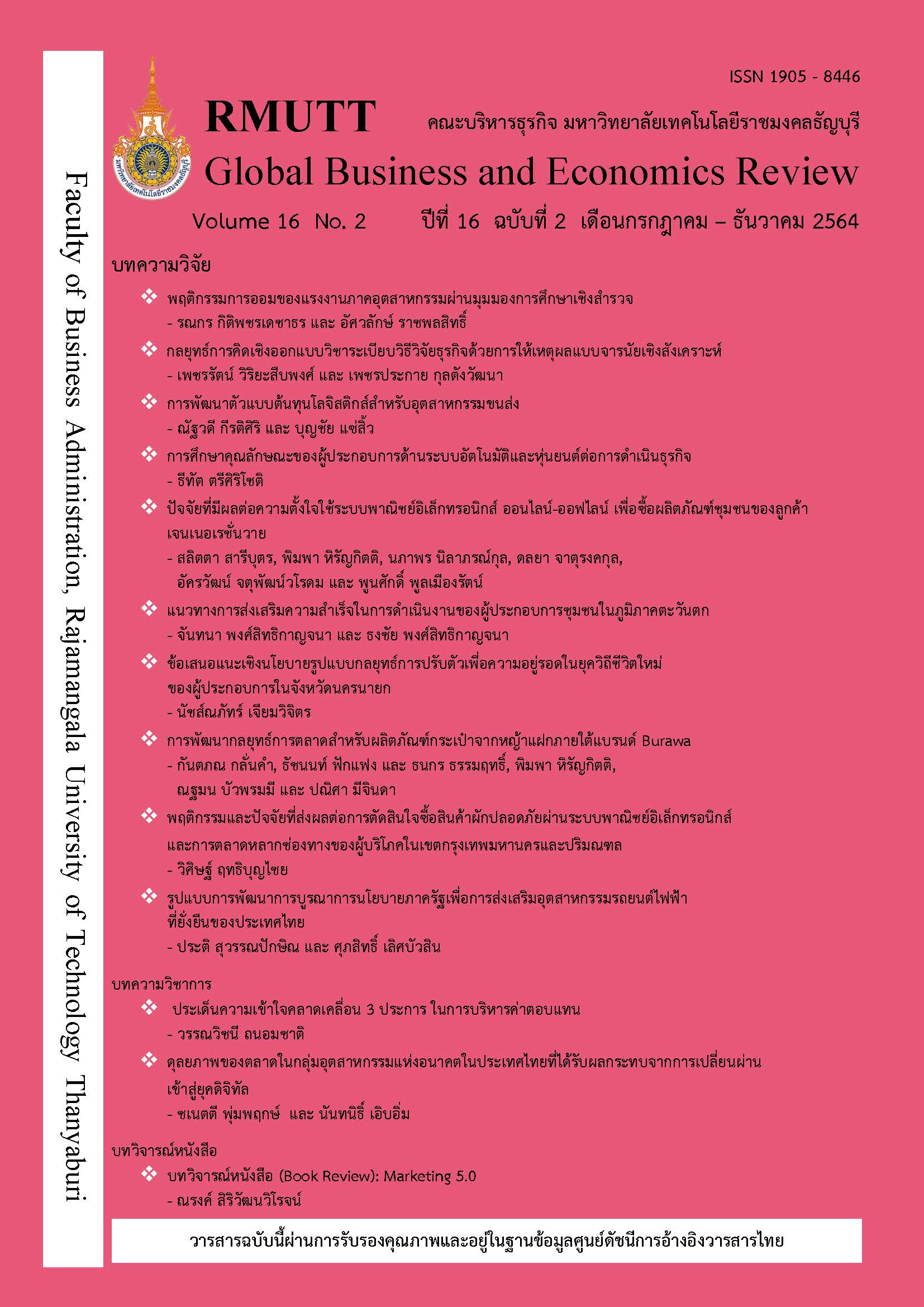BEHAVIOR AND FACTORS AFFECTING THE DECISION TO PURCHASE SAFE VEGETABLES PRODUCTS THROUGH E-COMMERCE AND MULTI-CHANNEL MARKETING OF CONSUMERS IN BANGKOK METROPOLITAN AND THE VICINITIES
Keywords:
Purchase Decision, Safe Vegetables, Multi-Channel MarketingAbstract
This research aims to study 1) Decision to buy safe vegetable products through electronic commerce and multi-channel marketing by personal factors 2) Factors affecting decision to buy safe vegetable products through electronic commerce and multi-channel marketing and 3) Guidelines for developing safe vegetable purchase decisions through electronic commerce and multi-channel marketing by using integrated research. Data was collected from 750 consumers of safe vegetable products through electronic commerce and multi-channel marketing in Bangkok and its vicinities. There were 3 key informants of safe vegetable products in Bangkok and its vicinities. In additional, content validity and reliability of questionnaire and structured interviews were applied in this research. The research results were found that: 1) The decision process to buy safe vegetables had multi-channel marketing. Differences were found both in overall and in terms of factors which was classified by personal factors such as age, status, education, income and occupation. 2) Safe vegetable purchasing decisions through multi-channel marketing was caused by the overall influence of the electronic marketing mix (TE = 0.78), but technology acceptance was caused by the overall negative influence (TE = -0.36) in statistically significant. It had a predictive power of 90 percent. 3) Guidelines for safe vegetable purchase decisions development through electronic commerce and multi-channel marketing, entrepreneurs must understand the differences of buyers with those who use the application to purchase that each group. Entrepreneurs must adapt for changing situations and trends in order to accept more technologies in a new way of life.
References
กรณษา แสนละเอียด, พีรภาว์ ทวีสุข และ ศรีไพร ศักดิ์รุ่งพงศากุล. (2560). การยอมรับเทคโนโลยีที่มีอิทธิพลต่อแนวโน้มความตั้งใจในการใช้บริการซื้อสินค้าผ่านช่องทางออนไลน์ของกลุ่มเบบี้บูมเมอร์ในกรุงเทพมหานคร. วารสารปัญญาภิวัฒน์, 9(3), 3-15.
กรมส่งเสริมอุตสาหกรรม. (2551). Training and Certification Program for APEC IBIZ: E-commerce. กรุงเทพฯ: สถาบันเพิ่มผลผลิตแห่งชาติ.
ขวัญกมล ดอนขวา, สุมาตรา โพธิ์มะฮาด และ นภิสรา พิษสุวรรณ. (2562). ปัจจัยส่วนประสมทางการตลาดที่มีผลต่อพฤติกรรมของผู้บริโภคในการซื้อผักปลอดสารพิษในจังหวัดนครราชสีมา. วารสารชุมชนวิจัย, 13(3), 81-93.
จิตรลดา วิวัฒน์เจริญวงศ์. (2562). ส่วนประสมการตลาดออนไลน์. สืบค้นจาก http://spssthesis.blogspot.sg/
ฉัตยาพร เสมอใจ. (2550). พฤติกรรมผู้บริโภค. กรุงเทพฯ: ซีเอ็ดยูเคชั่น.
ณัฏฐ์ พงษ์อัคคศิรา และ ปาลิดา ศรีศรกำพล. (2561). ปัจจัยส่วนประสมทางการตลาดที่ส่งผลต่อการตัดสินใจซื้อผักหวานป่าของผู้บริโภคในเขตจังหวัดราชบุรี. วารสารวิทยาการจัดการ มหาวิทยาลัยราชภัฏสุราษฎร์ธานี, 5(1), 59-80.
ฐานข้อมูลบูรพาจารย์มหาวิทยาลัยเกษตรศาสตร์. (2526). หม่อมเจ้าสิทธิพร กฤดากร. สืบค้นจาก http://archives.psd.ku.ac.th/kuout/p051.html.
ธเนศ อุ่นปรีชาวณิชย์. (2562). เงื่อนไขการเปลี่ยนผ่านพฤติกรรมการบริโภคที่ส่งผลต่อรูปแบบการบริโภคที่ยั่งยืนในประเทศไทย. วารสารวิทยาการจัดการ มหาวิทยาลัยราชภัฎนครปฐม, 6(1), 299-312.
ปิยะศักดิ์ ชมจันทร์. (2563). การขายสินค้าผ่านการสนทนาออนไลน์: แนวโน้มใหม่ของพาณิชย์อิเล็กทรอนิกส์. วารสารนิเทศสยามปริทัศน์, 19(1), 205-209.
รชิดา สิริดลลธี. (2561). การโฆษณาผ่านเกมเพื่อสื่อสารตราสินค้าในยุคดิจิทัล. วารสารนิเทศศาสตร์และนวัตกรรม นิด้า, 5(2), 20-45.
วสุธิดา นุริตมนต์. (2562). อิทธิพลของการยอมรับเทคโนโลยีที่มีต่อพฤติกรรมการใช้บริการธุรกรรมทางการเงินผ่านแอปพลิเคชันบนโทรศัพท์เคลื่อนที่. วารสารสหวิทยาการวิจัย ฉบับบัณฑิตศึกษา, 8(พิเศษ), 189-199.
วิเชียร วงศ์ณิชชากุล. (2550). การบริหารการส่งเสริมการตลาด. กรุงเทพฯ: สํานักพิมพ์มหาวิทยาลัยกรุงเทพ.
สิงหะ ฉวีสุข และ สุนันทา วงศ์จตุรภัทร. (2555). ทฤษฎีการยอมรับการใช้เทคโนโลยีสารสนเทศ. สืบค้นจาก http://www.journal.it.kmitl.ac.th
สิริชัย ดีเลิศ และ สุภาวดี รัตนพงศ์พันธ์. (2561).ปัจจัยที่ส่งผลต่อกระบวนการตัดสินใจซื้อสินค้าผ่านระบบพาณิชย์อิเล็กทรอนิกส์ของกลุ่มผู้บริโภคตลาดเฉพาะกลุ่ม. Veridian E-Journal, Silpakorn University, 11(1), 2404-2424.
สุรัชดา เชิดบุญเมือง, จิรวุฒิ หลอมประโคน และ วิสุทธ์ กล้าหาญ. (2557). ปัจจัยการตลาดและพฤติกรรมการซื้อสินค้าผ่านระบบพาณิชย์อิเล็กทรอนิกส์ของผู้บริโภคในเขตกรุงเทพมหานคร. วารสารปัญญาภิวัฒน์, 5(พิเศษ), 76-91.
ยุพิน พิทยาวัฒนชัย. (2555).การตลาดหลายช่องทาง:แนวทางที่จะทำให้ธุรกิจประสบความสำเร็จในยุคดิจิทัล. วารสารการจัดการธุรกิจ มหาวิทยาลัยบูรพา, 1(1), 33-48.
สำนักงานสถิติแห่งชาติ. (2564). รายงานสถิติรายปีประเทศไทย พ.ศ.2564. กรุงเทพฯ: สำนักงาน.
อาณัติ ลีมัคเดช. (2546). เรียนรู้พาณิชย์อิเล็กทรอนิกส์ ภาคทฤษฏีและปฏิบัติ. กรุงเทพฯ: เอ.อาร์.บิซิเนส เพรส.
อรุณี พึงวัฒนานุกูล. (2562). ส่วนประสมการตลาดผักปลอดสารพิษโครงการหลวงของผู้สูงอายุในเขตกรุงเทพมหานคร. วารสารวิชาการมหาวิทยาลัยปทุมธานี, 11(1), 278-282.
โอภาส เอี่ยมสิริวงศ์. (2556). พาณิชย์อิเล็กทรอนิกส์ (มุมมองด้านการบริหาร). กรุงเทพฯ: ซีเอ็ดยูเคชั่น.
Auno, R. (2016). Conflicts of supply chains in multi-channel marketing: a case from northern Finland. Journal Technology Analysis and Strategic Management, 28( 4), 477-491.
Davis, F. D., Bagozzi, R., & Warshaw, P. (1989). User acceptance of computer technology a comparision of two theoretical models. Management Science, 35(8), 982-1003.
Hair, J. F., Black, W. C., Babin, B. J., & Anderson, R. E. (2010). Multivariate data analysis (7th ed.). New York: Pearson.
Hongshuang, L., & Kannan, P. K. (2014). Attributing conversions in a multichannel online marketing environment: an empirical model and a field experiment. Journal of Marketing Research, 15(1). 40-56.
Kotler, P. (2003). Marketing Management (11th ed.). New Jersey: Prentice Hall.
Kushwaha, T., & Shankar, V. (2012). How valuable are multichannel customers? the moderating effects of product category on the relationship between channel preference and monetary value. UNC Kenan-Flagler Research Paper No. 2013-8. Retrieved from http://dx.doi.org/10.2139/ssrn.2056379
Ooi, K. B., & Tan, G. W-H. (2016). Mobile technology acceptance model: an investigation using mobile users to explore smartphone credit card. Journal of Expert Systems with Applications, 59, 33-46.
Pogorelova, E., Yakhneeva, I., Agafonova, A., & Prokubovskaya, A. (2016). Marketing mix for e-commerce. International Journal Of Environmental And Science Education, 11(14), 6744-6759.
Rogers, E. M. (2003). Diffusion of innovations (5th ed.). New York: The Free Press.
Tassabehji, R. (2003). Applying e-commerce in business. London: SAGE Publications.
Wertime, K., & Fenwick, I. (2008). Digi marketing: the essential guide to new media and digital marketing. UK.: John Wiley & Sons.
Downloads
Published
How to Cite
Issue
Section
License
The articles published in this journal are the intellectual property of their respective authors.
The views and opinions expressed in each article are solely those of the individual authors and do not reflect the positions of Rajamangala University of Technology Thanyaburi or any of its faculty members. All components and content of each article are the sole responsibility of the respective authors. In the event of any errors, the authors shall bear full responsibility for their own work.








